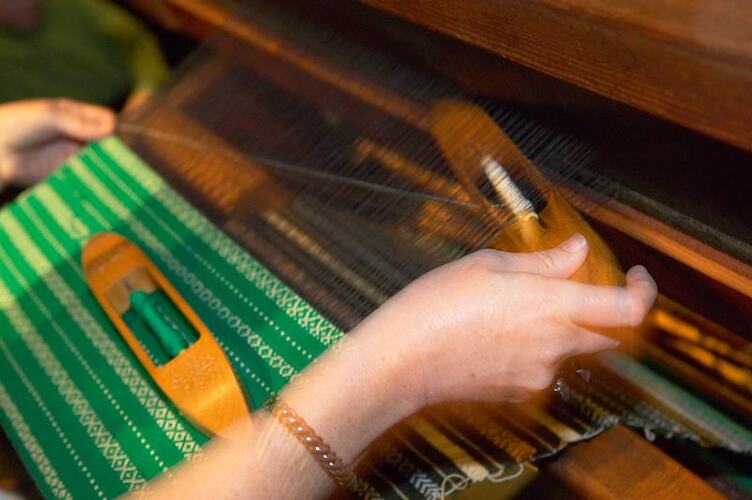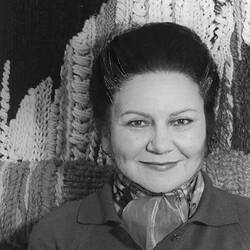Summary
The Immigration and Artistic Practice Collection contains over 140 artworks as well as related tools and materials used by the artists. It also contains 27 oral histories along with photographs and other support material relating to the artistic practice of over 30 immigrant artists living in Victoria.
The Immigration and Artistic Practice Collection consists of objects which represent the creative processes of first and second generation Australian artists. Artistic media is diverse, including sculpture, weaving, paintings, ceramics, wood carving and handcrafts; as well as tools, materials, designs, and equipment. Countries of origin of artists include Italy, Japan, Poland, Germany, Austria, China, South Africa, Chile, Hungary, Netherlands, Latvia, Laos (Hmong), Türkiye (formerly Turkey) (Kurdish) and Vietnam.
The collection was initiated in 1992 when Museum Victoria and Monash University received a project grant from the Australia Council to undertake a project to assess the effects that migration and exposure to new cultures had on traditional and non-traditional art and craft practices. Entitled Contemporary Craft and Cultural Identity, the project research was undertaken by Deborah Tout-Smith, supervised by Anna Malgorzewicz and Margaret Anderson. It identified and documented the work of several key artists and craftspeople including Anna and Anita Apinis, Martha Ash, Heja Chong, Leopoldine Mimovich, Naomi Ota, Josef Moser, Eva Schubert, Amelia Sello and the African Women's Group, and Maria Simari.
Museum Victoria continued to develop the collection through subsequent acquisition funding also granted by the Australia Council in 1995, acquiring works by artists listed above as well as other practitioners such as Lou Xiang, Magdalena Moreno and Hasan Bagdas. Re-named the Immigration and Artistic Practice Collection, the interpretation of the collection was expanded by new curators including Moya McFadzean, Rebecca Marsh and Susan Doyle, documenting more artists, types of art practices and countries, and further exploration of contemporary cultural identity and immigration experiences in Victoria. Oral histories undertaken with artists has been a key aspect of enriching the project and capturing the artists own voices as they reflect on their artistic practices.
Art/craft works represent a unique form of material culture. They are artefacts which have been created through conscious deliberation by individuals and groups living in specific social and historical contexts, and they thereby reveal much about the social production and contexts of ideas. They are also socially and historically significant in their intent, design, technique and production.
Consequently, it has been considered as important to document and collect the material culture of the processes of creativity as the end products themselves. A research archive containing oral histories, photographs and other documentation of participating artists has also been developed. The project seeks to nurture ongoing relationships with participating artists rather than simply acquire art/craftworks, as well as interpret and display items from the collection in a variety of exhibition contexts.
More Information
-
Keywords
Art, Artistic Practices, Artists, Artworks, Australiana, Austrian Immigration, Baltic Communities, Cambodian Communities, Cambodian Culture, Carving, Ceramics, Charities, Chinese Communities, Crafts, Croatian Communities, Cultural Identity, Cultural Maintenance, Cultural Traditions, Displaced Persons, Dutch Communities, Estonian Communities, Ethnic Groups, German Communities, Greek Communities, Handcrafts, Hindeloopen Art, Hmong, Hungarian Communities, Immigration, Italian Communities, Japanese Art, Japanese Communities, Japanese Culture, Jewish Community, Kurdish Communities, Laotian Communities, Laotian Culture, Latvian Communities, Leatherworking, Migrant Camps, Migrants, Migration & Settlement, National Costumes, Paintings, Polish Communities, Political Prisoners, Pottery, Refugee Children, Refugees, Sculpture, South Africa Culture, South African Communities, Theatrical Performances, Traditional Costumes, Vietnamese Communities, Vietnamese Culture, Visual Arts, Wars & Conflicts, Weaving, Women's Work, Wood Carvings, World War II, 1939-1945
-
Localities
Victoria, Australia, Italy, Japan, Germany, Austria, Poland, China, Chile, South Africa, Latvia
-
Authors
-
Article types

